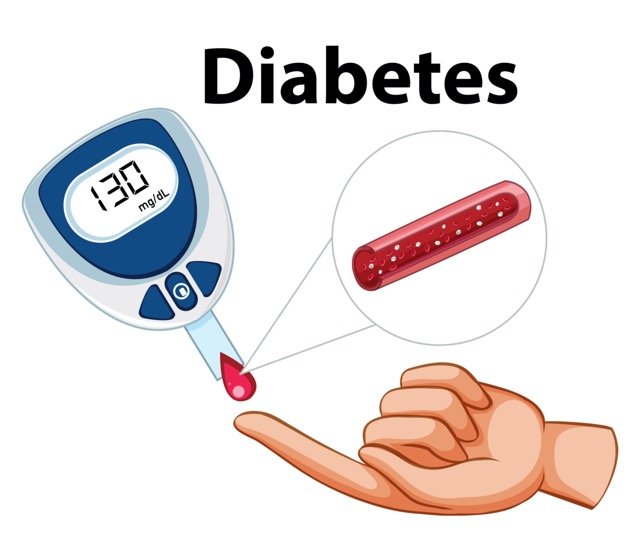Rosiglitazone (Avandia) is an antidiabetic medicine that belongs to the class of drugs called thiazolidinediones. It acts by activating PPAR-gamma receptors and increase insulin sensitivity. It also acts on the renal tubules and causes salt retention. This can lead to volume expansion and exacerbate heart failure and other conditions of volume overload. The drug has been banned in most countries because of its cardiovascular complications.
Rosiglitazone (Avandia) Uses:
-
Diabetes mellitus Type 2:
- It is used as a monotherapy or in combination with other antidiabetic drugs for the treatment of Diabetes Mellitus Type 2, as an adjunct to diet and exercise.
Rosiglitazone (Avandia) Dose in Adults
Rosiglitazone (Avandia) Dose in the treatment of type 2 Diabetes mellitus:
- 4 mg/day orally as a single dose or in two divided doses, initially.
- The dose may be increased to 8 mg per day in patients who do not achieve an adequate response after 8 to 12 weeks of the treatment.
- The maximum dose is 8 mg/day in one or two divided doses. Some studied recommend 4 mg twice daily instead of 8 mg once a day because of increased efficacy.
Note:
- A reduction in the dose of concomitant medications may be required in patients who are on multiple treatments and at risk of developing hypoglycemia.
Rosiglitazone (Avandia) Dose in Childrens
Rosiglitazone (Avandia) Dose in the treatment of Type 2 diabetes:
-
Children older than 10 years and Adolescents:
- 2 mg orally twice a day initially;
- The dose may be increased to 4 mg two times a day after 8 weeks in combination with metformin.
Rosiglitazone (Avandia) Pregnancy Risk Category: C/ D
- Rosiglitazone crosses the placental barrier.
- It should not be used during pregnancy. Preferable treatments like insulin and metformin should also be recommended to pregnant women.
- Poor fetal and maternal outcomes may be linked to both rosiglitazone use and diabetes that is poorly controlled.
- Poorly managed diabetic pregnant women are at greater risk for diabetic ketoacidosis and preeclampsia.
- They also face preterm delivery, stillbirths or major birth defects.
- Patients with diabetes should be able to have a planned pregnancy.
- They should also have closely controlled blood sugars prior to conception. The HbA should not be increased, but should remain within the target range.
- Thiazolidinediones can cause premenopausal women to ovulate in anovulatory women.
- This could increase the likelihood of unplanned pregnancy. Females with reproductive potential should avoid thiozilidineiones.
Rosiglitazone can be used during breastfeeding
- It is unknown if the drug will be excreted into breastmilk.
- Manufacturers recommend weighing the benefits and risks of drug exposure for the mother against the risks to the infant.
Dose in Kidney Disease:
Adjustment in the dose is not necessary in patients with kidney disease.
Rosiglitazone (Avandia) Dose in Liver disease:
- The manufacturer did not offer any suggestions regarding dosage adjustments for patients with liver disease.
- Patients with hepatic impairment have a significantly lower drug clearance.
- Patients with ALT levels more than 2.5 times the ULN, or with active liver disease should not receive treatment.
Common Side Effects of Rosiglitazone (Avandia):
-
Endocrine & Metabolic:
- Increased HDL Cholesterol
- Increased LDL Cholesterol
- Increased Serum Cholesterol
- Weight Gain
Less Common Side Effects Of Rosiglitazone (Avandia):
-
Cardiovascular:
- Edema
- Hypertension; Cardiac Failure
- Ischemic Heart Disease
-
Central Nervous System:
- Headache
-
Endocrine & Metabolic:
- Hypoglycemia
-
Gastrointestinal:
- Diarrhea
-
Hematologic & Oncologic:
- Anemia
-
Neuromuscular & Skeletal:
- Bone Fracture
- Arthralgia
- Back Pain
-
Respiratory:
- Upper Respiratory Tract Infection
- Nasopharyngitis
-
Miscellaneous:
- Trauma
Contraindications to Rosiglitazone (Avandia):
US Labeling Canadian labeling
- Allergy reactions to any component of the drug or the drug itself
- NYHA Class III and IV heart failure before treatment initiation.
- Allergy reactions to any component of the drug or the drug itself
- Heart Failure of any stage (NYHA Classes I, II and III or IV).
- Grave hepatic impairment
- Pregnancy
Warnings and precautions
-
Edema
- Particularly with increasing doses, the drug can increase plasma volume and cause fluid retention or edema.
- Patients who are unable to tolerate fluid overload, such as those suffering from heart disease, should not use it.
-
Fractures
- The risk of fractures associated with the drug use was particularly high in females.
- Patients with osteoporosis postmenopausal developed more fractures in the upper arm, hand and foot than those who had fractures in the spine and hip.
- Patients at higher risk of developing features should be cautioned about taking the drug.
-
Heart Failure and cardiac Effects: [US Boxed Warn]
- Fluid retention can be caused by thiazolidinediones and can lead to heart failure in patients with stable coronary disease.
- You should monitor your patients for signs of heart disease such as weight gain, dyspnea and orthopnea.
- Patients with heart failure may need to be prescribed a lower dose or discontinue treatment.
- Patients with symptomatic or severe heart failure, NYHA class III and IV (or any other class as per Canadian labeling) must stop receiving treatment.
- Patients with NYHA Class II or III heart failure have a higher incidence of cardiovascular events.
- It has been shown to increase the risk of myocardial and angina, as well as exacerbating your heart failure.
- Patients at high risk for developing heart attacks should be warned and closely monitored.
- Patients with cardiac disease should stop taking the medication.
-
Hematologic effects
- Patients treated with thiazolidinediones have seen a decrease in hemoglobin, hematocrit and/or WBC counts.
- These hematologic parameters could be dose-related or may be related with volume expansion.
- Hematological abnormalities are most common in the first three months after treatment initiation and following dose escalation.
- Patients suffering from anemia should be cautious.
-
Hypoglycemia
- Hypoglycemia can occur in patients who are taking insulin and other glucose-lowering drugs.
- It may be necessary to reduce the dosage of hypoglycemic drugs.
-
Macular edema
- Macular edema, a common side effect of thiazolidinedione therapy, is well-known.
- Patients might present with reduced vision or impaired visual acuity.
- It is important to monitor patients regularly. Patients with visual impairments should be evaluated promptly
- The effects of stopping taking the drug could be improved.
-
Weight loss
- Fluid retention and fat accumulation may cause weight gain due to dose-related effects.
-
Bariatric surgery
- Absorption altered:
- Bariatric surgery can cause anatomical changes that may alter the absorption of the drug, resulting in glycemic dysregulation.
- Weight loss
- Treatment may cause weight gain. After gastric bypass, gastric banding and sleeve-gastrectomy, it is important to consider the risks and benefits of drug therapy.
- Absorption altered:
-
Hepatic impairment
- Patients with hepatic impairment must be cautious when taking the drug.
- Rosiglitazone should not be given to patients with liver disease or ALT levels exceeding 2.5 times the ULN prior to treatment initiation.
- Patients who have ALT levels 2.5 times or lower than the ULN before or during treatment should be examined for the reason.
- Patients with ALT levels more than 3x the ULN should have their treatment re-evaluated. If the repeat ALT level is not consistent with the ULN, or if jaundice is observed at any point during treatment, the treatment should be stopped.
- Troglitazone has been linked to idiosyncratic liver toxicities. Patients who have had jaundice since troglitazone treatment are advised to stop using it.
- Patients with hepatic impairment must be cautious when taking the drug.
-
Ischemic heart disease
- Patients with heart disease should not use it as it can cause fluid retention which could lead to heart failure and other cardiovascular complications.
-
Stress-related disorders:
- In cases of stress, such as hospitalizations, surgery, trauma, infection or other forms of treatment, the treatment might need to be stopped.
- In such cases, alternative therapies such as insulin should also be available.
Rosiglitazone: Drug Interaction
|
Abiraterone Acetate |
May increase the serum concentration of CYP2C8 Substrates (High risk with Inhibitors). |
|
Alpha-Lipoic Acid |
May enhance the hypoglycemic effect of Antidiabetic Agents. |
|
Androgens |
May enhance the hypoglycemic effect of Blood Glucose Lowering Agents. Exceptions: Danazol. |
|
Atazanavir |
May increase the serum concentration of Rosiglitazone. |
|
CYP2C8 Inhibitors (Moderate) |
May decrease the metabolism of CYP2C8 Substrates (High risk with Inhibitors). |
|
Deferasirox |
May increase the serum concentration of CYP2C8 Substrates (High risk with Inhibitors). |
|
Direct Acting Antiviral Agents (HCV) |
May enhance the hypoglycemic effect of Antidiabetic Agents. |
|
Guanethidine |
May enhance the hypoglycemic effect of Antidiabetic Agents. |
|
Hyperglycemia-Associated Agents |
May diminish the therapeutic effect of Antidiabetic Agents. |
|
Hypoglycemia-Associated Agents |
Antidiabetic Agents may enhance the hypoglycemic effect of Hypoglycemia-Associated Agents. |
|
Letermovir |
May increase the serum concentration of Rosiglitazone. |
|
Lumacaftor |
May increase the serum concentration of CYP2C8 Substrates (High Risk with Inhibitors or Inducers). Lumacaftor may decrease the serum concentration of CYP2C8 Substrates (High Risk with Inhibitors or Inducers). |
|
Maitake |
May enhance the hypoglycemic effect of Blood Glucose Lowering Agents. |
|
Monoamine Oxidase Inhibitors |
May enhance the hypoglycemic effect of Blood Glucose Lowering Agents. |
|
Pegvisomant |
May enhance the hypoglycemic effect of Blood Glucose Lowering Agents. |
|
Pregabalin |
May enhance the fluid-retaining effect of Thiazolidinediones. |
|
Prothionamide |
May enhance the hypoglycemic effect of Blood Glucose Lowering Agents. |
|
Quinolones |
May enhance the hypoglycemic effect of Blood Glucose Lowering Agents. Quinolones may diminish the therapeutic effect of Blood Glucose Lowering Agents. Specifically, if an agent is being used to treat diabetes, loss of blood sugar control may occur with quinolone use. |
|
Ritodrine |
May diminish the therapeutic effect of Antidiabetic Agents. |
|
Salicylates |
May enhance the hypoglycemic effect of Blood Glucose Lowering Agents. |
|
Selective Serotonin Reuptake Inhibitors |
May enhance the hypoglycemic effect of Blood Glucose Lowering Agents. |
|
Thiazide and Thiazide-Like Diuretics |
May diminish the therapeutic effect of Antidiabetic Agents. |
|
Trimethoprim |
May decrease the metabolism of Thiazolidinediones. |
|
Vasodilators (Organic Nitrates) |
May enhance the adverse/toxic effect of Rosiglitazone. Specifically, a greater risk of ischemia and other adverse effects has been associated with this combination in some pooled analyses. |
|
Cholestyramine Resin |
May decrease the serum concentration of Rosiglitazone. Management: Administer rosiglitazone at least 2 hours prior to cholestyramine in order to minimize the likelihood of an interaction, and monitor patients closely for evidence of reduced rosiglitazone effectiveness. |
|
Dabrafenib |
May decrease the serum concentration of CYP2C8 Substrates (High risk with Inducers). Management: Seek alternatives to the CYP2C8 substrate when possible. If concomitant therapy cannot be avoided, monitor clinical effects of the substrate closely (particularly therapeutic effects). |
|
Gemfibrozil |
May decrease the metabolism of Thiazolidinediones. Management: Limit pioglitazone maximum adult dose to 15 mg/day, and consider dose reduction of rosiglitazone, when used in combination with gemfibrozil. |
|
MiFEPRIStone |
May increase the serum concentration of CYP2C8 Substrates (High risk with Inhibitors). Management: Use CYP2C8 substrates at the lowest recommended dose, and monitor closely for adverse effects (including myopathy), during and in the 2 weeks following mifepristone treatment. |
|
RifAMPin |
May increase the metabolism of Thiazolidinediones. Management: Consider alternatives to the concomitant use of rifampin with thiazolidinedione antidiabetic agents. Monitor patients receiving these combinations for decreased effects of the thiazolidinedione derivative. |
|
Sulfonylureas |
Thiazolidinediones may enhance the hypoglycemic effect of Sulfonylureas. Management: Consider sulfonylurea dose adjustments in patients taking thiazolidinediones and monitor for hypoglycemia. |
|
Insulins |
May enhance the adverse/toxic effect of Rosiglitazone. Specifically, the risk of fluid retention, heart failure, and hypoglycemia may be increased with this combination. |
Monitoring parameters:
- Monitor Hemoglobin a 1c quarterly for patients who have not met their glycemic goals and twice yearly for patients who have achieved their targets.
- Fasting and random blood glucose
- Before treatment begins, and regularly thereafter.
- Patients who have ALT levels 2.5 times or lower than the ULN before or during treatment should be examined for the reason.
- Patients with ALT levels higher than 3x the ULN should have their treatment rechecked. If the repeat ALT level is greater than 3x the ULN, the treatment should be stopped.
- Fluid overload should be checked on patients regularly. Dose adjustments should also be made.
- Keep an eye out for weight gain
- Assess the risk of fractures
- A visual examination should be performed at least once every two years, or more often in patients with symptoms.
How to administer Rosiglitazone (Avandia)?
It may be administered orally without regard to meals.
Mechanism of action of Rosiglitazone (Avandia):
- It is a thiazolidinedione, which increases insulin sensitivity in the target cells but does not increase pancreatic insulin secretion.
- Insulin is required for the mechanism to work. It activates the PPAR gamma (peroxisome proliferator activated receptor-gamma).
- Activation at the nuclear PPARgamma receptors can have an impact on a variety of gene products involved in glucose or lipid metabolism.
- Additionally, PPARgamma receptors can be found in large numbers in the renal collecting tubes. This causes an increase in sodium reabsorption as well as fluid retention.
The onset of action:
- Delayed
- The maximum effect may be seen up to 12 weeks
Protein binding:
- 99.8% is bound to plasma proteins, primarily albumin.
Metabolism:
- It is metabolized in the liver (99%) via CYP2C8.
- Minor metabolism occurs via CYP2C9
Bioavailability:
- 99%
Half-life elimination:
- 3 to 4 hours.
- In patients with moderate to severe hepatic impairment, the half-life elimination is prolonged by approximately 2 hours.
Time to peak plasma concentration:
- One hour (delayed with food)
Excretion:
- Urine (~64%)
- feces (~23%) as metabolites
International Brands of Rosiglitazone:
- Avandia
- Algor
- Avaglit
- Avandia
- Diaglinex
- Reglit
- Rezult
- Rosidexx
- Rosix
- Vidya
- Winsepal
- Xilan
Rosiglitazone Brand Names in Pakistan:
Rosiglitazone 2 mg Tablets |
|
| Blutab | Werrick Pharmaceuticals |
| Diaroz | Medizan Labs (Pvt) Ltd |
| Glizon | Vega Pharmaceuticals Ltd. |
| Re-Cont | Mass Pharma (Private) Limited |
| Rosiscot | Scotmann Pharmaceuticals |
| Rosiser | Panacea Pharmaceuticals |
Rosiglitazone Tablets 4 mg |
|
| Blutab | Werrick Pharmaceuticals |
| Diaroz Forte | Medizan Labs (Pvt) Ltd |
| Glandia | Pulse Pharmaceuticals |
| Glizon | Vega Pharmaceuticals Ltd. |
| Rosiscot | Scotmann Pharmaceuticals |
| Rosiser | Panacea Pharmaceuticals |
Rosiglitazone Maleate Tablets 8 mg |
|
| Blutab | Werrick Pharmaceuticals |
| Glandia | Pulse Pharmaceuticals |
| Glizon | Vega Pharmaceuticals Ltd. |
| Rosiser | Panacea Pharmaceuticals |







